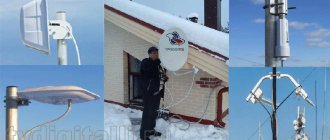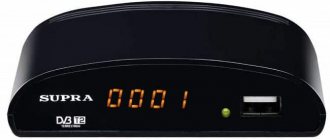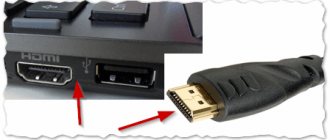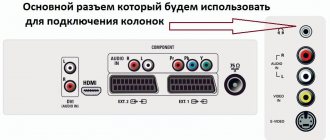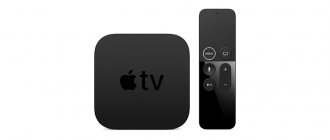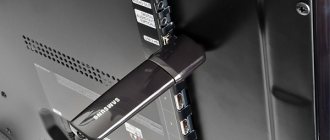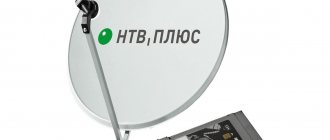Some restrictions
Satellite broadcasting is an analogue radio signal that many people are not familiar with. The TV program, video and sound are transmitted in the form of code sequences in digital format. This means that older TVs that are not equipped with a special decoder cannot receive satellite channels. This requires separate equipment. In modern TV models this is a DVB-S, DVB-S2 tuner.
DVB-S2 tuner
Today, satellite TV providers offer set-top boxes for decoding the signal into a format understandable to a regular TV receiver. In the standard antenna operation scheme, a receiving dish and a TV are connected to one such device. If you use two imaging devices, they will display the same picture and nothing else.
Simple connection option
For the simplest connection option, the user must have at least one tuner that has a so-called radio signal bypass. That is, the same data that the device receives from a satellite dish is transmitted to its high-frequency radio channel output. In this case, you can build a line of at least a couple of set-top boxes for watching channels on several TVs. This is done like this:
- the antenna cable is inserted into the input of the set-top box with radio output;
- the output of the first receiver is connected to the corresponding input of the second;
- TVs are connected to set-top boxes using HDMI, RCA, and other ports.
Some difficulties may arise when implementing this method. In particular, most receivers do not have a completely end-to-end bypass. If the device is configured to work with channels in vertical polarization, its output will be a signal of the same format. That is, on the second set-top box you cannot watch programs broadcast in horizontal polarization.
The second difficulty is related to the peculiarity of how providers work with subscriber identification using smart cards or other means. If the service provider does not support viewing premium channels on two screens, the user will be forced to limit himself. On one TV he will have access to all subscriptions and TV programs, and on the second - only free ones.
Connecting two TV receivers
To connect a second television receiver to your existing digital set-top box, you need to understand that you will not be able to watch different channels on several televisions (be it 2, 3 or more).
Important! The technical capabilities of a digital tuner allow you to transmit only one program (channel) to several television receivers.
However, you can connect several receivers to one dish (satellite dish) using a divider and thus ensure the broadcast of a separate program on each TV. For such connection options, see the figures:
Connection to different connectors
There are several methods you can use to connect more than one television receiver to one TV tuner. If the TV set-top box has several types of output connectors (Skart, RCA, HDMI, etc.), then you can connect each TV to different outputs (see fig.). However, you need to remember that a low-frequency signal passing through an HDMI or RCA cable quickly fades and can completely disappear at a distance of more than 10 meters.
HDMI connection
In the case when the set-top box is equipped only with an HDMI output, to connect several TVs you will need an HDMI splitter with the required number of outputs. In this case, all connected TVs must have an HDMI input connector. The length of connecting cables for such a connection should also not exceed 10 meters.
Connection to RF output
Using a receiver with a high-frequency (HF) output (RF output) is the best option for connecting several TVs located more than 10 meters from each other . Owners of receivers with RF output, for example, GS U510 Full HD, just need to purchase a television signal divider (splitter, splitter) with the required number of outputs. All connections are made using regular 75 ohm RF cable. If necessary, you can additionally install a television signal amplifier between the receiver and the splitter, which will help improve image quality.
Connection via RF modulator
There are quite a lot of TV tuners that do not have an RF output (Tricolor GS B211, etc.). In this case, the connection of television receivers located at a large (more than 10 m) distance from the set-top box is carried out using an RF modulator, which is connected to the low-frequency output of RCA or Skart. Having connected an RF modulator to one of these connectors of the receiver, install a splitter with the required number of outputs at the output of the latter and connect them to the TVs with a 75-ohm RF cable (see example in the figure). Then one of the television channels is set on the RF modulator and all televisions are configured. If the quality of the television signal does not satisfy the user, then you can install an additional RF amplifier between the splitter and the TV.
So, connecting two television receivers to one tuner is possible, but this will require additional devices such as a divider, an RF modulator or an RF amplifier. But even in this case, only one channel will be broadcast on both TVs, and it will be possible to switch programs only in the room where the receiver is installed directly. You should also remember about the decrease in the quality of video material when reproducing a digital signal, which is also affected by the length of the cable that connects the TV receivers to the set-top box. However, this problem can be solved by purchasing a splitter with a built-in amplifier.
Antenna modification
The number of outputs that a satellite dish has is dictated by the design of its converter. By replacing this unit with a more advanced one, you can get several cable lines for different TVs at once. Today there are converters on sale with 2, 3, 4 and up to 8 outputs. This method is most convenient for those users who have enough free channels.
4 output converter
To implement such a connection scheme, in addition to replacing the converter, you will have to install new wires throughout the house. However, the subscriber is offered maximum freedom. You can connect a receiver-TV pair to each cable, use the services of one provider with the option of viewing on multiple screens, or take advantage of offers from two or three operators at once.
There will be no problems with choosing polarization; this task is solved by separate set-top boxes. But there are also some disadvantages. The most important thing is that you may have to pay a subscription fee for each receiver or group of tuners.
How to connect a second TV to a set-top box
If you want to watch digital television on several television receivers, you can activate from Beeline. It allows you to watch your favorite programs on two, three or four TV screens through separate and synchronized digital receivers. You can activate the option completely free of charge; there is no subscription fee for its use.
The advantage of this connection method is that the user will be able to install television panels and connected digital receivers in different rooms and run not one television channel on them at the same time, but different ones. This will avoid arguments about whose favorite shows to watch today.
To connect, you will need a main Beeline TV receiver with the ability to record television broadcasts and a hard drive, as well as several additional digital tuners that connect to additional television receivers. In this case, recording of programs will be available not only on the first, but also on the second and other TVs. To use the service, you need to rent or purchase a main set-top box and a second one (or more), as well as pay for the channel package you are interested in, by default – a basic one with 139 channels.
It will be available on the second and subsequent receivers, as well as the recording of the broadcast. Only recording of channels in HD resolution is performed only on the main receiver. The user can order configuration and connection of equipment from the company’s specialists, but, knowing the procedure, you can perform these actions on your own.
Necessary:
- Connect the Ethernet cable to the switch that comes with the Beeline TV receiver and plug the device into a power outlet.
- Connect the patch cable to the free connectors of the switch (for example, to the second one) and to the Beeline set-top box.
- Connect the receiver and TV with an HDMI, RCA or SCARD wire.
- Turn on both devices.
- Make sure that the port indicators on the switch are lit with the network cable and set-top box connected. This means that the signal is being sent to the television panel.
- On the TV set, select the connector to which the receiver is connected as the signal source.
- The first download and switching on of the receiver takes up to 15 minutes, after which the owner of the equipment will be able to start watching television channels.
To connect a second TV to digital television, TVs No. 3 and No. 4, you need to connect a wire from the switch to set-top boxes in other rooms, and from them direct an HDMI or RCA wire to the TV screen (depending on what outputs the device has). HDMI is preferred because it provides a better picture compared to regular tulips. It is not recommended to set up digital television wirelessly via Wi-Fi. In this case, the connection speed and signal quality may deteriorate not only on the second, but also on the first TV screen.
Signal dividers
The signal divider is a very simple device. It has one entrance and several exits. There are two types of divider splitters. Some devices generate the same signal level at all outputs. They are used in cases where the lengths of cable lines to each TV are approximately equal.
The second type is called a nonlinear divider. One of its outputs has 60-70% of the level of the original signal. The furthest TV on the network is connected to it.
As can be seen from the operating principle of the divider, TV receivers or receivers receive a much smaller signal than the antenna generates. Therefore, it is rational to use amplifiers in a home network. They are connected in front of the consumer, set-top box or TV to get high-quality picture and sound from satellite broadcasts.
Services of satellite providers
Dividers, multiswitches, cascade connection of receivers - all this does not eliminate the main problem of distributing a satellite signal to several TVs. If the provider uses subscriber identification, you will have to pay a separate subscription fee for each set-top box or TV. Fortunately for users, modern providers understand that there can be at least two TVs in the house.
Tricolor for 2 TVs
Service providers offer the option of watching channels on multiple devices. There are also hardware solutions - these are so-called connected receivers. One of them acts as the main server. It decodes channels. Data is transferred to the second receiver-client via a local computer network cable or via a wireless router.
Clone mode
In cafes, summer recreation areas, even in private homes, clone mode can be useful. In this case, two TVs receive the same picture. You can make such a connection to one receiver. Each of the TVs is switched to a separate port. At the same time, RCA and HDMI lines can be very long, from 5 to 30 meters.
Necessary equipment
To successfully implement his plan and connect two TVs to one receiver, a home master will need:
- a simple set of cable stripping tools;
- parabolic antenna or just a dish;
- TV tuner;
- splitter or splitter for two outputs;
- two TVs;
- a set of necessary cables.
When all the components have been purchased, you can begin installing the entire system, but before that, a few words about the devices.
Setting up system components
Before connecting the tuner, you need to configure it:
- connect the receiver to the home electrical network;
- connect the product to the computer via a USB port;
- install the satellite dish and connect it to a special connector on the tuner;
- install the software that comes with the product;
- launch the program and configure operating parameters.
Only after careful configuration do we begin to connect the connected tuner to the TVs. To do this, it is better to use digital inputs to maintain the much-needed image quality.
Let's say that one TV is installed in the living room, and the other connected object, for example, is in the son's room: then we connect the nearby TV to the receiver with an HDMI cable. We turn on the TV in the hall and begin tuning it:
- go to the menu;
- select the signal source;
- indicate the connector to which you connected from the tuner;
- We make the settings according to the product instructions; as a rule, we choose automatic scanning, which modern models perform independently;
- After the list of channels appears, we filter out low-quality and duplicates, leaving only those necessary for further viewing.
Connecting a second receiver
Now it's time to tell you how to connect a second TV to the receiver. We measure the shortest distance; a good option is to drill into the adjacent wall, but this is not always possible. The cable must be routed along the baseboard so as not to touch it when moving around the apartment.
There are special skirting boards on sale with a cutout for cables; they are closed with a lid on top, which is very convenient - the wires are hidden and do not disturb the interior.
Setting up the second TV is carried out in a similar way, with the obligatory indication of the connected cables in the case when more than one of them is used.
We connect the satellite tuner using an RCA cable, which can be used when simultaneously connecting two TVs to one receiver along with HDMI. You will need a special SCART-RCA adapter, and when setting up a TV connected using this cable, you will need to change the input signal settings. The scheme of such a connection is simple, it is carried out economically - there is no need to purchase additional expensive equipment.
What you need to connect
To connect one antenna to two TVs, you will need several parts:
- A special splitter or splitter for several outputs. Using this device, you can split the signal in such a way that you get several stable streams. There are several types of devices in stores, and you should choose depending on the parameters of the received signal. The equipment is equipped with several inputs. One is designed to connect to an antenna, the other two to a TV.
- 5 connectors that will be connected to the splitter. They must be compatible with the splitter.
- Several adapter plugs.
- Antenna cable.
When you come to the store to buy equipment to connect two TVs, you should not confuse the number of outputs on the splitter. On sale you can find a three-way unit that is used to connect more than two TV receivers.
It is not suitable for pair TV connection. If you have to use a triple splitter, then you need to connect a ballast resistor with a resistance of 75 Ohms to the free hole.
Tuner selection
If a user wants to watch digital TV, he needs to connect to one tuner that receives a video signal. In modern TVs, the equipment is pre-installed by the manufacturers and a digital set-top box is not needed.
You can find a variety of models in stores.
Among them, you should choose the appropriate option depending on the specific conditions:
- The satellite tuner is connected directly to the dish.
- The cable receiver receives the signal via the television wire.
- A tuner for terrestrial TV receives a signal from nearby television centers through compact equipment.
- The Wi-Fi receiver is designed to connect via a wireless network to interactive digital television via the Internet.
When purchasing a tuner, you should pay attention to:
- The type of broadcasting used depends on the location of the house.
- TV signal standard.
- The number of TVs that the receiver can support.
- Additional equipment capabilities.
- Availability of remote control.
- Controls on the body. They will come in handy if the remote control fails.
- Availability of an intuitive menu for easy device control.
- Necessary connectors for connection, including HDMI.
By the way, take a closer look at Beeline TV (not advertising). I use it and am happy with everything. When purchasing, you should always ask the seller for warranty and service availability, as well as information about the manufacturer. This way you can count on the quality of the product, through which you can connect two TVs to the antenna.
Selecting a splitter
A splitter is necessary if you want to connect two TVs to one antenna. The device consists of a metal case with several connectors. There is a chip installed inside.
To choose the right model, you must:
- Select a channel with the highest frequency and select a separator such that the upper limit of its frequency range is greater than the obtained indicator.
- Determine how many TVs need to be connected to one antenna.
- Find out the amount of attenuation of the TV signal. The lower the indicator, the more stable the user will receive the image quality.
